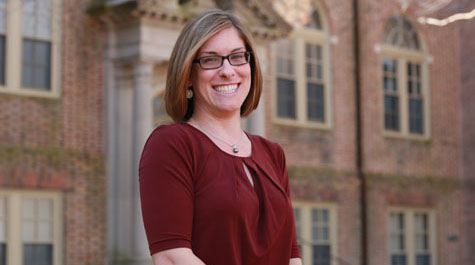The fabric of a forgotten Hawaiian community
Summer Moore was clad in a white tee and colorful infinity scarf as she philosophized on the significance of fabric: “It’s a form of self-expression,” she said. “You can learn a lot about someone based on how they use it or adapt it.” But, for Moore, the most intriguing fabrics aren’t the ones she keeps in her closet. What captivates her most is a collection of faded, tattered cloth pieces, some no bigger than a handkerchief.
Moore, a Ph.D. student in anthropology at William & Mary, has spent the past year studying a collection of European cloth fragments that were recovered from a remote archaeological dig site in Hawaii, where she lived for years. Her research, which recently won the Market Access International, Inc., Award for Excellence in Scholarship in the Humanities and Social Sciences, aims to better understand how an isolated Hawaiian community was affected by European contact in the early 19th century. She’ll be honored at a luncheon at the 15th annual Graduate Research Symposium on March 19.
Moore first landed in Hawaii the way most people probably do: “I thought it’d be fun,” she says, “especially after a job monitoring gas pipelines in Wyoming in the winter for years.” So, in 2011, she packed her bags and crossed the Pacific, eventually landing a job at the Bernice Pauahi Bishop Museum in Honolulu as collections manager. That’s where she discovered drawers of artifacts reclaimed from a rocky enclave on the north shore of Kauai called Nu’alolo Kai. Excavated in the ‘50s and ‘60s, it was among the first archaeological dig sites in Hawaii.
“The area was protected by a rock overhang, so it didn’t get exposed to weather patterns the way most places do,” Moore said. “The preservation of these artifacts was incredible.”
Most intriguing of all was the presence of a small, but still significant, amount of imported European cloth, which appeared to have been cut, torn, or twisted into pieces that altered their form and purpose. “Cloth is almost never studied in archaeology because it’s typically the first thing to disintegrate,” said Moore. “The novelty of it was interesting, but it also presented a challenge because I’m not trained in identifying or dating it.”
What was known, however, was when and why Europeans first established contact with Hawaii. In 1778, Captain James Cook became the first European explorer to arrive in Kauai, opening the gates for trading ships for years following. In exchange for provisions and sandalwood, Europeans would leave behind foreign goods, including ceramic, glass and cloth.
“The people who visited tended to be merchant sailors, so it makes sense that many of the cloth pieces were rougher utilitarian fabrics, sort of like canvas or sailcloth,” said Moore, who analyzed the cloth in person and, later, with high-resolution scans she took of each fragment. “Many appear to be clothing remnants, but their size suggests they weren’t used as clothing at Nu’alolo Kai.”
One explanation for this, said Moore, is that the people of Nu’alolo Kai viewed foreign goods such as cloth as prestige items, exotic in their texture and colors, and therefore kept them as souvenirs or altered them to fit their lifestyle. A piece of European canvas, for example, was found twisted into an oil lamp wick, just as the native people would have done with their traditional “kapa” fabric (made from beaten tree bark).
“A dish wasn’t necessarily used as a dish,” she said. “It could be broken up into pieces and divided. The people at Nu’alolo seemed to be taking foreign objects out of their context and making them into a special token with new meaning and value.”
Whether that was by choice or necessity is up for debate. Situated in a valley surrounded by towering cliffs, the community could only be accessed by sea, and even then only when the swells were agreeable. This suggests that perhaps it was a sheer scarcity of visitors that prevented Nu’alolo Kai from acquiring more foreign items, said Moore. Just 2-5 percent of the artifacts recovered at the site were European; in comparison, a study done at an excavation site on Oahu’s North Shore found that the people of a semi-isolated community during the same era filled their homes with almost entirely European items.
“This little unit seemed to maintain its own degree of independence and autonomy, more so than other communities around Hawaii, some of whom changed their whole way of life,” said Moore. “So one thing I’m looking at is what people were doing here that might be different from what people in other nearby communities were doing.”
This summer, Moore will travel back to Hawaii with her advisor, Assistant Professor of Anthropology Jennifer Kahn, to study an excavation site adjacent to Nu’alolo Kai.
She also hopes to visit the cloth collection at the Bishop Museum again to have microscopic photos of the fragments taken, which will hopefully shed more light on the exact identity of the foreign materials and their impact on the native Hawaiian community.
“I think many anthropologists tend to think of the contact period as something that happened one day and then it was over,” she says. “But there’s evidence that people were slowly incorporating foreign objects into their lives over decades — and not in the way we might think. I think that shows it was a period of transition and less of a dividing line. If we choose to ignore this period, we’re missing a time of really dynamic social change.”
 Skip to main content
Skip to main content

